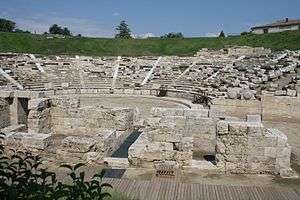First Ancient Theatre, Larissa
The First Ancient Theatre of Larissa (Greek: Α' Αρχαίο Θέατρο Λάρισας) is a major open-air theatre and the largest theater in Thessaly, with a seating capability of 10,000 people. It is situated on the south side of the Frourio Hill in Larissa.
Α' Αρχαίο Θέατρο Λάρισας | |
 | |
 First Ancient Theatre of Larissa Location within Greece | |
| Address | Mitropolitou Arseniou 10–12 |
|---|---|
| Location | Larissa |
| Coordinates | |
| Type | Ancient Greek theatre |
| Capacity | 10,000 |
| Construction | |
| Built | Early 3rd century BC |
| Closed | 3rd/4th century AD |
| Demolished | 7th century AD |
| Builder | Antigonus II Gonatas |
| Website | |
| www | |
History
The First Ancient Theatre of Larissa was constructed inside the ancient city's centre during the reign of King Philip V of Macedonia, towards the end of the 3rd century BC. The theatre was in use for six centuries, until the end of the 3rd century AD (or the beginning of the 4th century AD), when its operation was abruptly stopped.
During the first centuries, the theatre served a dual purpose: apart from theatrical performances, it also hosted the assemblies of the senior regional authority, the so-called Koinon of the Thessalians. The ancient theatre of Larissa by the end of the 7th century BC had the lead and completely prevailed over a large area of fertile plain of Thessaly.
The ancient theatre was initially connected to the worship of the God Dionysus, by conducting theatrical and music activities, and, secondly, with the administration of the Thessalian for meetings of the city assembly, called agora. Indications for these are a small votive altar to the god Dionysus found near the theater, and the names of representatives of the city-state who participated in the Federation of Thessaly shown on the seats of the ancient theater. The theatre has the typical structure of the Hellenistic theater with three basic components: koilon (hollow), orchestra and skene (stage) with a diameter of about 25 meters. The hollow of the ancient theater was the same slope of the hill fortress, which was shaped into terraces for the placement of benches.
In the second period, at the 2nd half century BC front of the stage building, towards the band built a colonnade, the limelight. It consists of six pilasters and Doric semi-columns six monolithic bloc.
At the time of the emperor Octavian Augustus and his successor Tiberius, there were found inscriptions in their honor on the foreheads of the Doric order entablature cornices of the scene.
The First Ancient Theatre of Larissa, which is today a hallmark of the city and the most important tourist monument in the area, is under excavation and ongoing maintenance being conducted by local authorities.